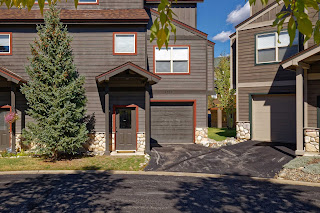#Summit County #Colorado
| Courtesy of the Summit County Builders Association |
Extravagant mansions of Summit County opened their doors for the 22nd annual Parade of Homes.
Starting on Sept. 17 and running for two weekends, the Parade of Homes gave tours of 15 properties. On Friday, Sept. 16, the Summit County Builders Association gave out 36 awards at the Silverthorne Pavilion. The homes fit into seven categories determined by the square footage of the home: Single-family homes had eight sections, and the remodeled and mutli-family homes had five apiece. Nine judges came from around the country to look at the homes.
“It is the best part of the year without a doubt. It’s the one time where you can slow down from all the craziness that’s going on and just show people what you create,” said Paul Steinweg, vice president of construction with Pinnacle Mountain Homes, who has been showing houses in the parade for the last nine years.
According to Marilyn Hogan, executive officer of the Summit County Builders Association, the parade has raised a total of $255,911 for the foundation during that time. While they are still calculating the totals for this year, Hogan said they had good attendance during the two weekends. Last year’s event raised nearly $36,000.
Steinweg estimated a 20 percent raise in attendance from last year. On Sept. 24, Pinnacle had 667 people come through for a tour.
Steinweg has been participating in the Parade of Homes with Pinnacle every year the company has entered. For him, one of the best parts of the parade is the sense of community the attendants have. He said he often sees the same faces year after year.
But Steinweg said his favorite part is showing the hard work that goes into building the homes to a community that appreciates it. This year he noted seeing a lot of parents bringing children who had an interest in architecture.
“Being able to pass one of those kids my Microsoft Surface with a plan on it and say, ‘Hey, walk through the home and tell me what changed,’ that was just so cool, just to see young people getting engaged in it, too,” Steinweg said.
CATEGORY 1 (3,000-4,999 SQUARE FEET)
Exterior Design and Elevation: 310 High Park Court, Silverthorne (Trilogy Partners, LLC)
Kitchen: 310 High Park Court
Master Bedroom: 1790 Golden Eagle Road, Silverthorne (Mathison Custom Homes)
Interior Finishes: 310 High Park Court
Interior Furnishings: 310 High Park Court
Landscaping and Outdoor Living Space: 530 Highfield Trail, Breckenridge (New West Partners)
Builder Concept and Workmanship: 1790 Golden Eagle Road
Best Overall: 310 High Park Court
CATEGORY 2 (5,000-5,999 SQUARE FEET)
Exterior Design and Elevation: 126 Hamilton Trail, Silverthorne (Trilogy Partners, LLC)
Kitchen: 126 Hamilton Trail
Master Bedroom: 38 Wildcat Road, Breckenridge (Pinnacle Mountain Homes)
Interior Finishes: 38 Wildcat Road
Interior Furnishings: 38 Wildcat Road
Landscaping and Outdoor Living Space: 38 Wildcat Road
Builder Concept and Workmanship: 38 Wildcat Road
Best Overall:38 Wildcat Road
CATEGORY 3 (6,000-7,999 SQUARE FEET)
Exterior Design and Elevation: 600 Ptarmigan Ranch Road, Dillon (Mountain Log Homes of Colorado)
Kitchen: 600 Ptarmigan Ranch Road
Master Bedroom: 368 Hamilton Court, Breckenridge (Infinite Scope)
Interior Finishes: 600 Ptarmigan Ranch Road
Interior Furnishings: 600 Ptarmigan Ranch Road
Landscaping and Outdoor Living Space: 368 Hamilton Court
Builder Concept and Workmanship: 600 Ptarmigan Ranch Road
Best Overall: 600 Ptarmigan Ranch Road
CATEGORY 4 (8,000 AND ABOVE SQUARE FEET)
422 Timber Trail, Breckenridge (Pinnacle Mountain Homes) received the awards for all eight categories for single-family homes.
CATEGORY 5 (3,999 SQUARE FEET AND UNDER REMODELED HOME)
0099 Lookup Lane, Frisco (Travis Construction) received the awards for all five categories for remodeled homes.
CATEGORY 6 (4,000-6,000 SQUARE FEET REMODELED HOME)
Structural Alterations: 2153 Keystone Ranch Road, Keystone (K.C. Custom Builders)
Exterior Aesthetics: 157 Riverwood Drive, Breckenridge (Trilogy Partners, LLC.)
Interior Architectural Alterations: 160 Lodge Pole Drive, Frisco (Raptor Construction)
Interior Aesthetic Alterations: 157 Riverwood Drive
Sustainability: 1884 Montezuma Road, Keystone (Kitchenscapes and Colorado Mountain Homes)
CATEGORY 7 (MULTI-FAMILY HOMES)
318 Flyline Drive, Silverthorne received the awards for all five categories for multi-family homes. The categories include Overall Floor Plan, Curb Appeal, Interior Finishes, Interior Furnishings, and Sustainability.
SPECIAL AWARDS:
High Country Conservation Center “Energy Conservation Award”: 530 Highfield Trail
Coldwell Banker Mountain Properties “Best Lifestyle Home Award”: 422 Timber Trail
Bank of the West “Best Bunk Room Award”: 422 Timber Trail
Mountain Living Peak Award: 600 Ptarmigan Ranch Road
Courtesy of the Summit Daily News.

